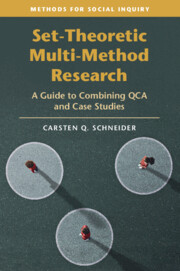4 - Conjunctions
A*B⇒Y
Published online by Cambridge University Press: 22 February 2024
Summary
The second element of causal complexity consists in the presence of conjunctions. In this chapter, the analytic consequences for SMMR are detailed and solutions for containing these consequences are formulated. Those strategies consist in applying further SMMR principles and in selecting cases based on whether their selection adheres to those principles. Learning goals: - Understand the challenges for causal inference SMMR designs triggered by conjunctions - Learn about how additional principles guide case selection in causal inference SMMR designs in the presence of conjunctions - Distinguish between focal and complementary conjuncts - Get acquainted with ranks for cases and case pairs in causal inference SMMR designs and how those ranks reflect which SMMR principles are fulfilled and which ones are violated - Learn about INUS conditions that qualify as necessary for the outcome and the consequences this triggers for purposeful case selection in causal inference SMMR designs - Understand the reasons why increased complexity of QCA solution formulas in the form of conjunctions also increases the complexity of causal inference SMMR designs
Keywords
- Type
- Chapter
- Information
- Set-Theoretic Multi-Method ResearchA Guide to Combining QCA and Case Studies, pp. 91 - 140Publisher: Cambridge University PressPrint publication year: 2024

